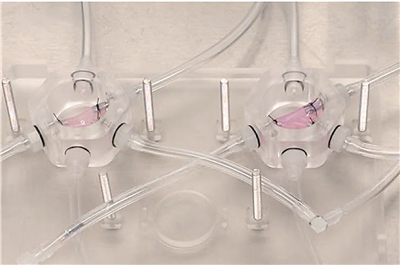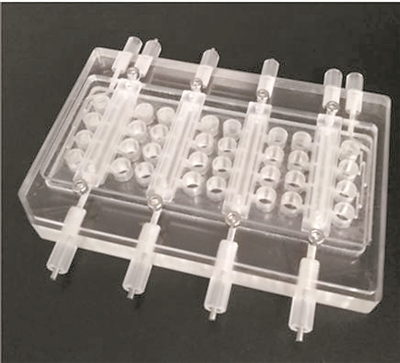-
Organs-on- chips device
The core of organ chip device-microfluidic chip
Microfluidic chip is the core of organs-on-chips laboratory. The research of organs-on-chips involves chip material, size, design, processing and surface modification. A microfluidic chip is a technology characterized by manipulating fluids in a micrometer-scale space. It has the ability to shrink the basic functions of chemistry and biological laboratories onto a chip a few square centimeters in size. Understanding the entire process of chip preparation and understanding the importance of chip design is the basis of organs-on-chips research. The keypoint in the field of organs-on-chips real face room is the technology of chip design and manufacturing first.
Commonly used microfluidic chip materials and properties
1) Requirements for the selection of microfluidic chip materials:
a. Good chemical and biocompatibility;
b. Good electrical insulation and heat release;
c. Good optical performance;
d. Good modifiability, can produce electroosmotic flow or immobilized biological macromolecules;
e. The process is simple and the cost is low.
2) Common materials:
Commonly used materials for making microfluidic chips are monocrystalline silicon wafers, quartz, glass and organic polymers such as polymethylmethacrylate (PMMA), polydimethylsiloxane (PDMS), polycarbonate (polycarbonate, PC) and hydrogel.
a. Silicon has good chemical inertness and thermal stability. Using photolithography and etching methods, it is possible to reproduce two-dimensional patterns or complex three-dimensional structures with high precision. The deficiencies of silicon materials are fragility, high price, opacity, poor electrical insulation, and complex surface chemical behavior, so their application in microfluidic chips is limited.
b. Quartz and glass have good electroosmosis and excellent optical properties. Their surface adsorption and surface reaction capabilities are conducive to surface modification, but the price is relatively high, especially quartz. Microstructures can be engraved on quartz and glass using photolithography and etching techniques similar to silicon wafers. Therefore, quartz and glass materials have been widely used to make microfluidic chips. Quartz is especially suitable for the production of microfluidic chips for detection by ultraviolet spectrophotometry.
c. Macromolecular polymers are characterized by many types, convenient processing and molding, and low raw material prices. They are very suitable for mass production and have low material costs. There are three main types of high molecular polymers used in the manufacture of microfluidic chips: thermoplastic polymers, cured polymers and solvent-volatile polymers. Thermoplastic polymers include PMMA, PC, and polyethylene; cured polymers include PDMS, Epoxy resin and polyurethane, etc., after they are mixed with the curing agent, after curing for a period of time, they can be hardened to obtain chips; solvent-volatile polymers include acrylic, rubber, and fluoroplastics, etc., which are dissolved in an appropriate solvent during production Then, the chip is obtained by slowly evaporating the solvent. The elastic PDMS material, also known as silicone rubber, is one of the more used polymers. It can transmit ultraviolet light above 250nm; durable, has certain chemical inertness; good biocompatibility, cheap; can be reversible and repeatedly deformed without permanent damage; can be used to replicate microfluidics with high fidelity by molding Chip; the surface of the chip microchannel can be modified and modified; it can not only reversibly combine with itself, but also reversibly combine with glass, silicon, silica and oxidized polymers.
3) Paper chip:
Recently, a microfluidic chip that uses paper (such as filter paper, chromatography paper and nitrocellulose membrane, etc.) as a chip manufacturing material and a biochemical analysis platform has also been successfully developed. Through fine processing on paper / like materials, micro-channels and related analysis units with target structures can be obtained. Based on the miniaturization, automation, integration and portability of the analysis platform, it is the current microfluidic analysis The system provides a brand new technology platform.
The paper chip has many significant advantages, such as simple production, low cost, small size, light weight, easy storage and transportation, good biocompatibility, low sample / reagent consumption, fast analysis speed, and can realize sample transportation by its own porous structure. No external driving force is required.
Paper as a chip material has the following advantages over traditional test strips. ① The paper chip forms a network with micro channels and a controllable fluid throughout the system. It has the advantages of quantitative, fixed speed, uniform fluid, etc., and can simultaneously detect multiple Samples or multiple indicators to achieve higher throughput; ② The minimum width of the paper chip microchannel can reach 100um, and only a small amount of reagents and samples can be used to achieve trace analysis, further reducing the cost of testing; ③ The paper chip can also be assembled Into a three-dimensional structure, multi-step separation, purification and detection can be completed with only one injection.
Production technology
Due to the micron-scale structure of the basic components of the microfluidic chip, it is required to strictly control the environment during the preparation process. The environmental indicators involved here usually include: air temperature, air humidity, air and particle density in various media used in the preparation process. The higher environmental requirements for chip production generally need to be achieved in a clean room.
The microfluidic chip needs to build micrometer-level channels and other components on the selected material substrate. The smoothness of the inner wall is very high, and special microfabrication technology is required. Microfabrication technology is a technology that transfers graphics to a chip with high precision, mainly including lithography and etching, etc. It has been widely used in the production of semiconductors and integrated circuits.
The basic process of micro-processing technology for glass and other chips includes gluing, exposure, development, corrosion and degumming. The manufacturing technology of polymer microfluidic chips is very different from glass chips. The manufacturing technology used Mainly include hot pressing method, molding method, injection method, laser ablation method, LIGA method and soft etching method.
Fluid drive and control in microfluidic chip
The application basis of the microfluidic chip is the driving and control of microfluid in the microchannel. In the chip laboratory, fluid drive methods can be generally divided into two categories: one is mechanical drive methods, including pneumatic micropumps, piezoelectric micropumps, reciprocating micropumps, centrifugal force drives, etc. Mainly uses the movement of its own mechanical components to achieve the purpose of driving fluids. The driving system contains moving mechanical components; the other type is non-mechanical driving methods, including electroosmotic driving, gravity driving, etc., which is characterized by the system itself without active machinery component. Systems with gravity drives are sometimes called pumpless systems.
Signal detection in microfluidic chip
2) Fast response speed
1) Sensitivity
During the operation of the microfluidic chip, the volume of the substance that can be detected is small (microliter, nanoliter or even pico-upgrade), and the detection area is generally very small, which requires the detector to have a higher detection sensitivity.
device.y
Due to the small size of the chip microchannel, many mixing reactions and separation processes are often completed in a very short time (seconds or even shorter), so the detector is required to have a faster response speed.
3) Small size
The ultimate goal of the chip laboratory is to integrate as many functional units as possible on the same microchip. Therefore, the detector as the output terminal is required to have a small volume, and it is best to be directly integrated on the chip.
References
1.林炳承,罗勇,刘婷娇,陆瑶,《器官芯片》,科学出版社,北京,2019年11月第一版。
2.顾忠泽,徐华,朱存,杜鑫,生物医学工程中的物理化学,科学出版社,北京,2019年4月第一版。
3.Westbrook Weaver HK, Manjima Dhar, Dino Di Carlo, Research highlights: Microfluidic point-of-care diagnostics. Lab on a Chip, 2014, 14:1962-1965.
4.Seo KD, Kim DS, Sanchez S, Fabrication and applications of complex-shaped microparticles via microfluidics. Lab on a Chip, 2015, 15(18):3622-3626.
Jump device list

Vascular organ chip device

Brain tumor organ chip device

3D tumor chip high-content imaging system developed by Southeast University and Southeast University Suzhou Medical Device Research Institute
The organ chip imaging analysis system based on artificial intelligence algorithm can perform fully automatic high-throughput imaging analysis of 3D tumor spheres/organoids cultured in vitro. Combined with our self-developed 3D tumor chip drug screening kit, stable and uniform 3D tumor spheres/organoids can be obtained. Through artificial intelligence deep learning technology, it realizes functions such as automatic scanning, automatic focusing, automatic image acquisition and splicing, and multi-scale automatic analysis of 3D cultured cell microspheres/organoids to provide rich biological information.